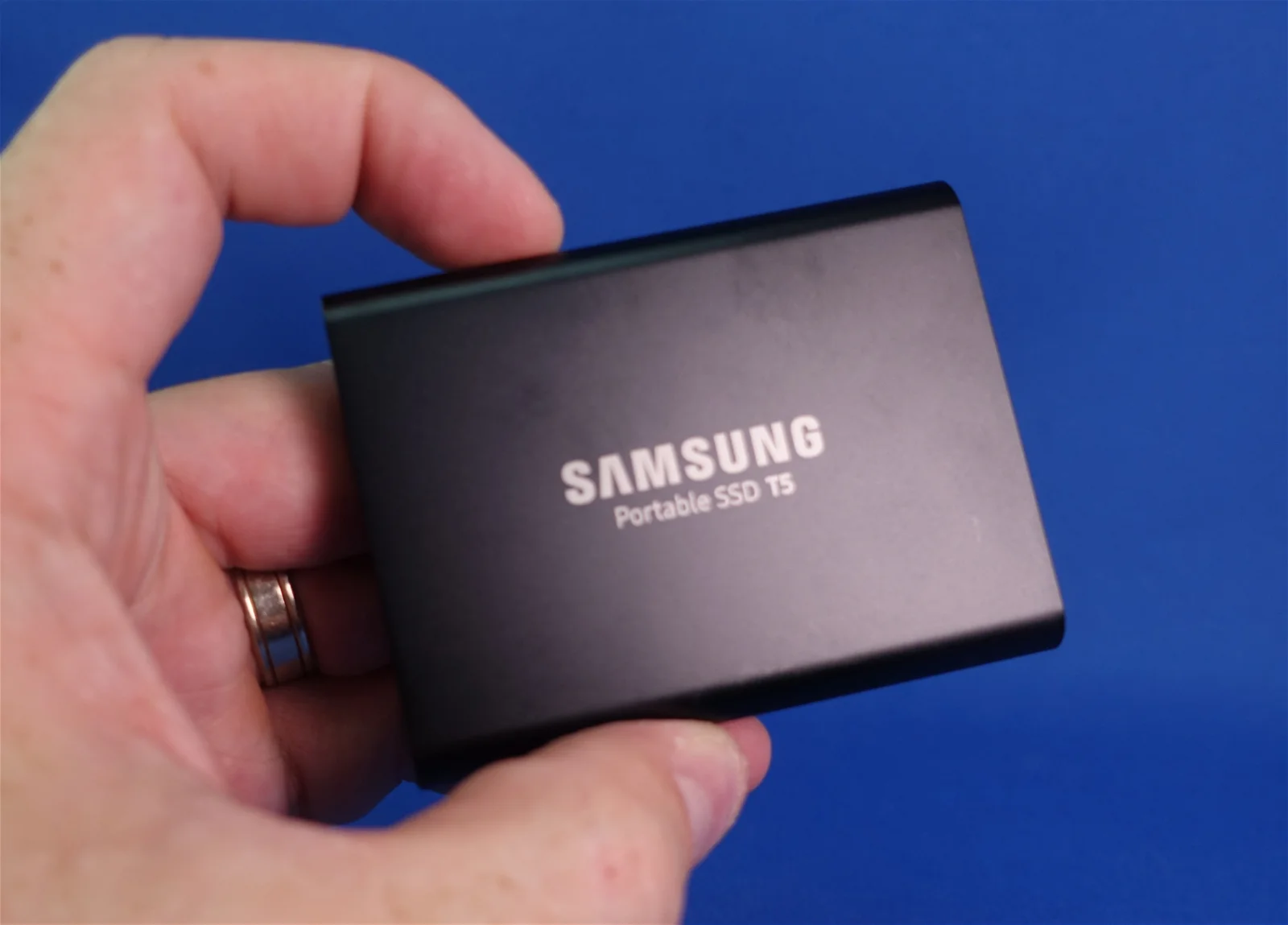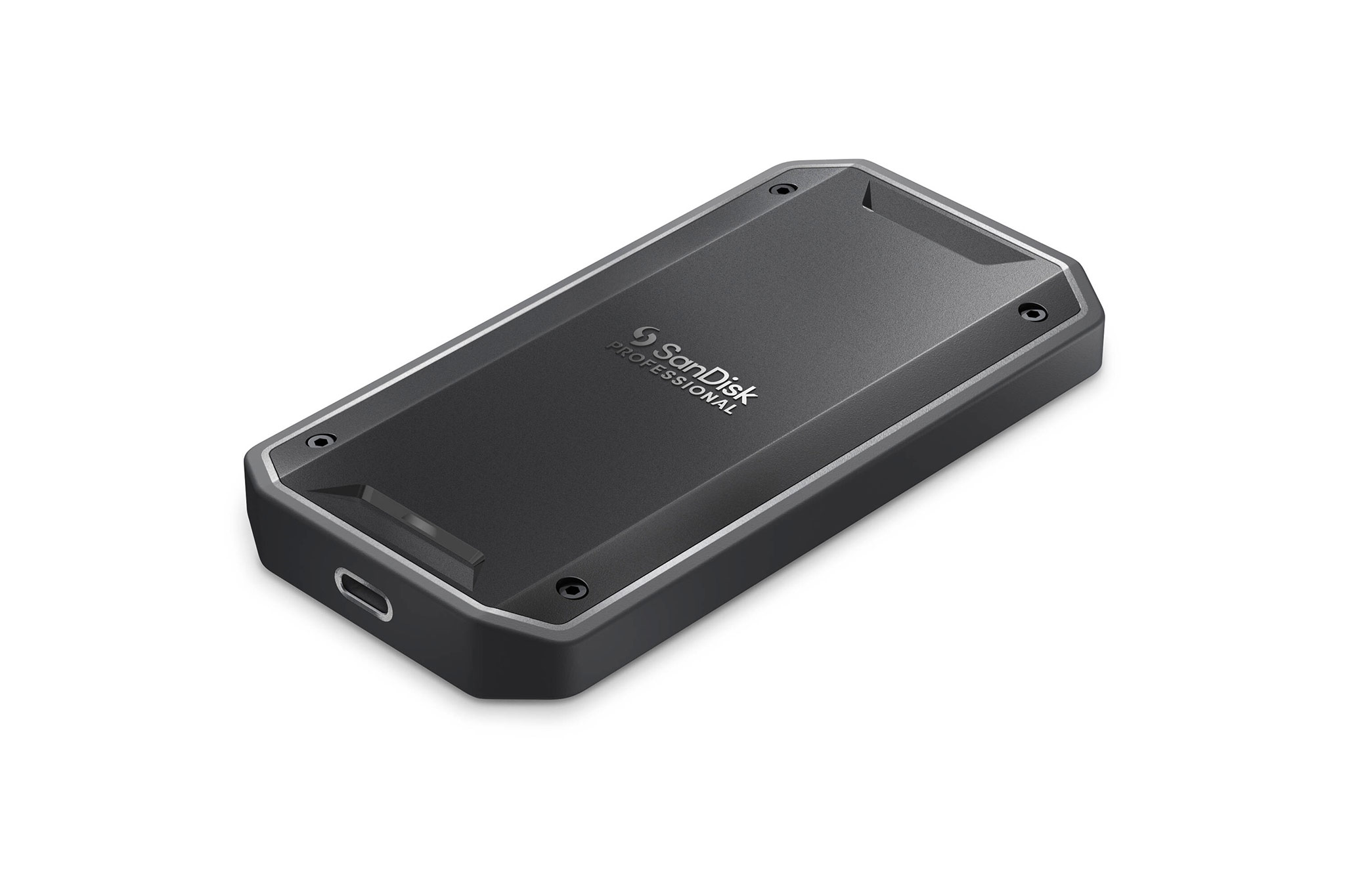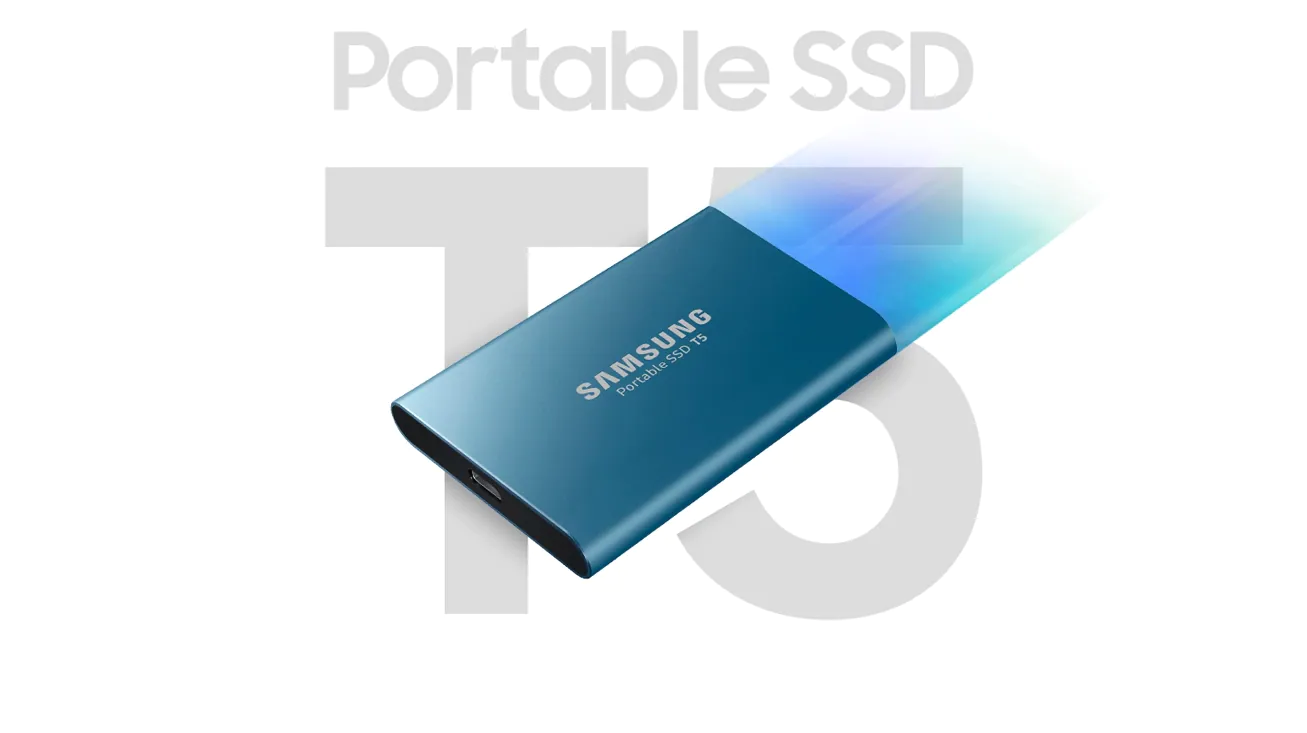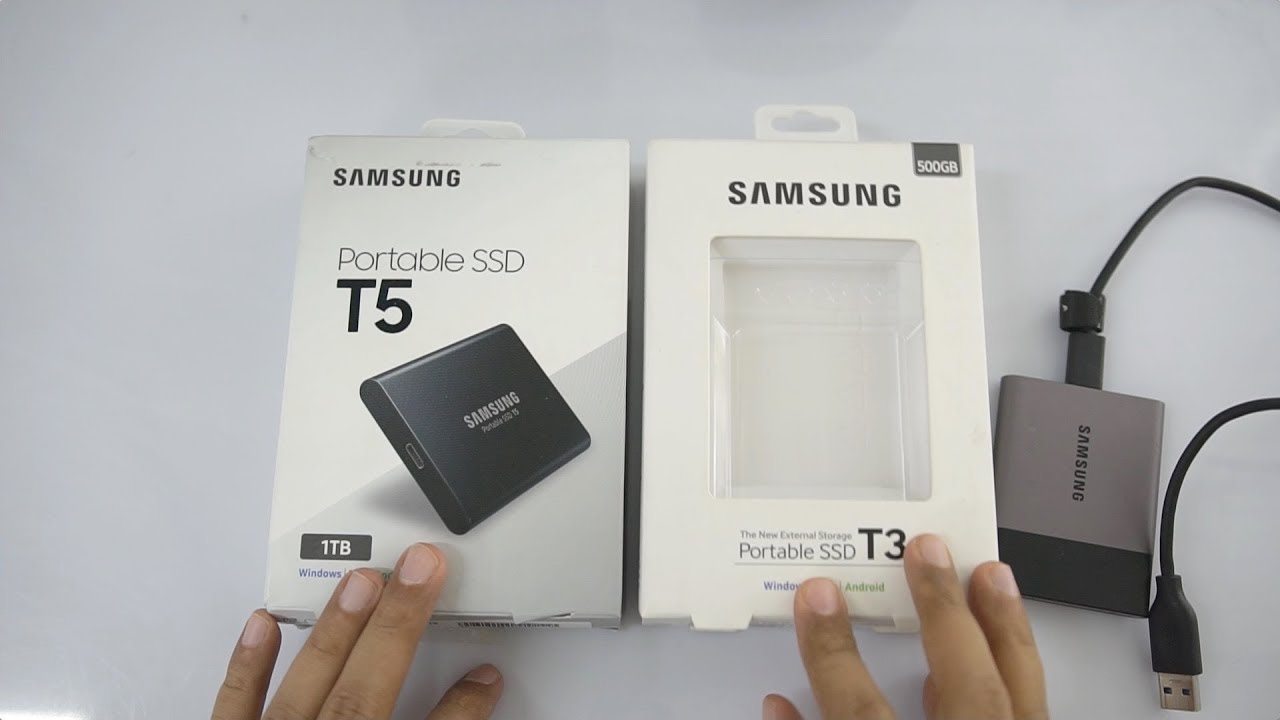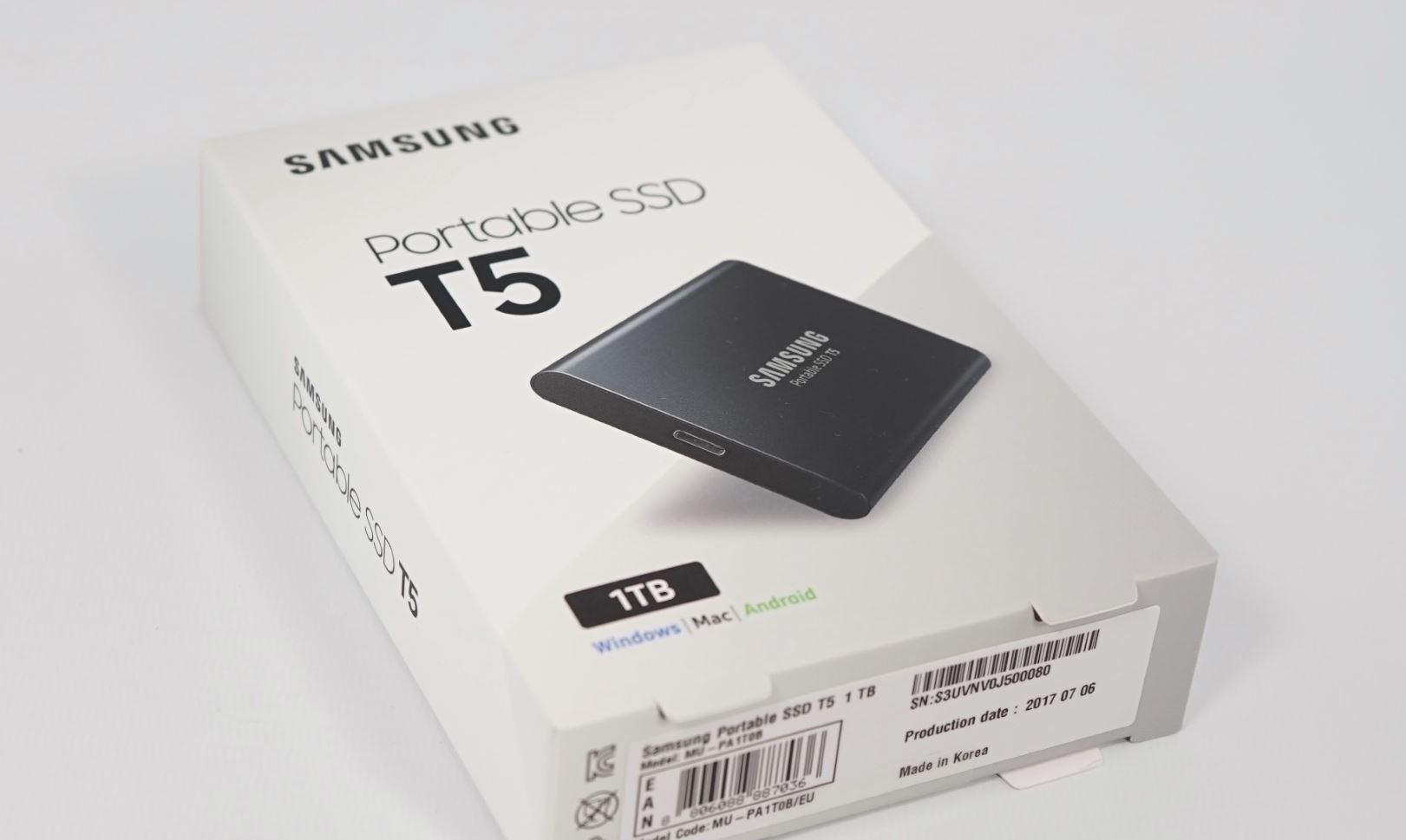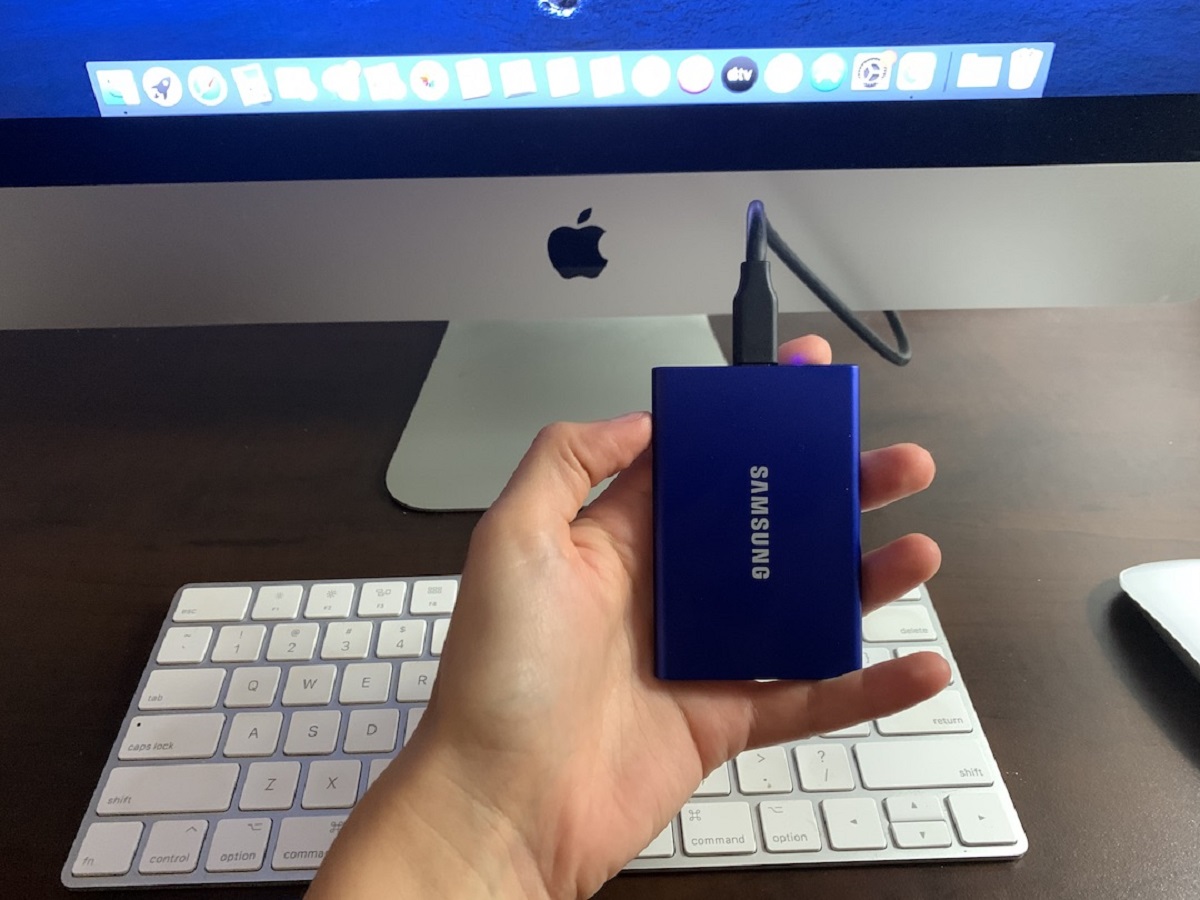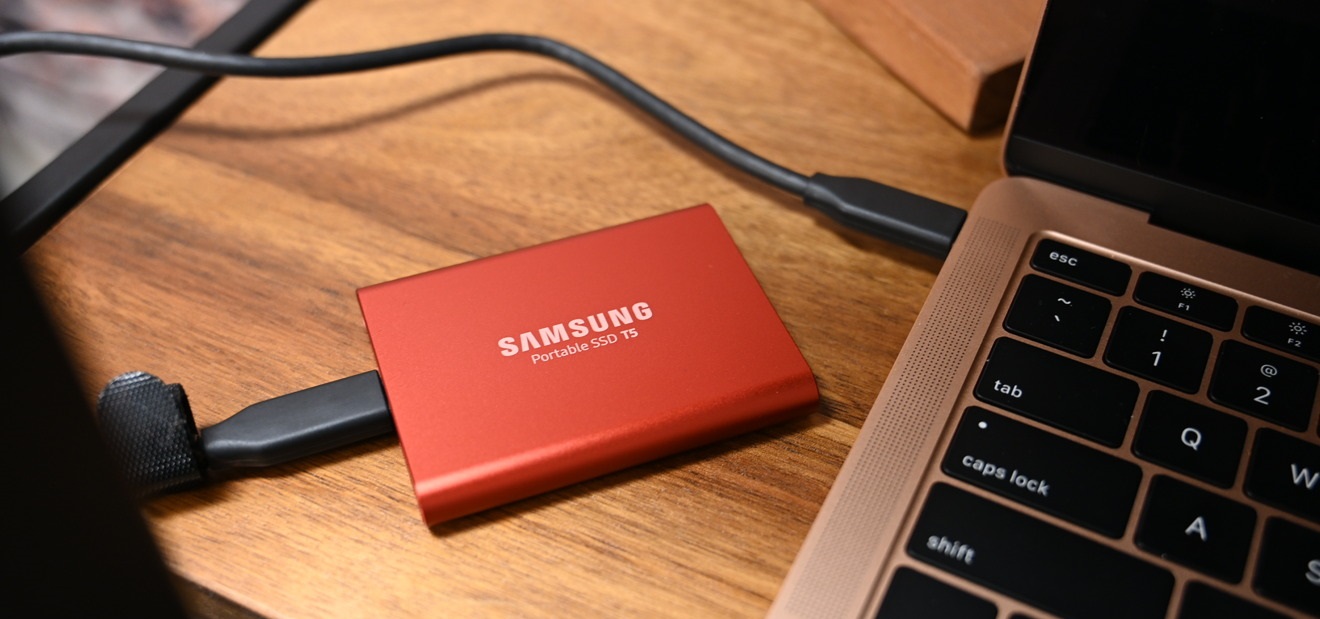Introduction
Welcome to our guide on how to use the Samsung Portable SSD T5! The Samsung Portable SSD T5 is a convenient and portable storage solution that allows you to take your files with you wherever you go. Whether you’re a student, professional, or casual user, this SSD offers fast and reliable storage for your documents, photos, videos, and more.
The Samsung Portable SSD T5 features a sleek and compact design, making it ideal for on-the-go use. It offers impressive transfer speeds, thanks to its USB 3.1 Gen 2 interface. With capacities ranging from 250GB to 2TB, you’ll have plenty of space to store all your important files and media.
In this guide, we will walk you through the process of connecting the Samsung Portable SSD T5 to your device, setting it up for the first time, transferring files, accessing your files, safely ejecting the SSD, managing storage space, encrypting and securing your data, and troubleshooting common issues.
Whether you’re a proficient computer user or new to external storage devices, this guide will provide you with step-by-step instructions and helpful tips to make the most out of your Samsung Portable SSD T5. By the end of this guide, you’ll be equipped with the knowledge and skills to effectively use your SSD and maximize its storage capabilities.
So, let’s get started with how to connect the Samsung Portable SSD T5 to your device and begin harnessing the power of portable storage!
Connect the Samsung Portable SSD T5 to Your Device
Before you can start using your Samsung Portable SSD T5, you’ll need to connect it to your device. The process is simple and can be done in a few easy steps:
- Start by locating the USB Type-C cable that came with your Samsung Portable SSD T5. This cable is used to establish a connection between the SSD and your device. If your device does not have a USB Type-C port, you may need to use an adapter.
- Insert one end of the USB Type-C cable into the USB Type-C port on the Samsung Portable SSD T5. The port is located on the side of the SSD.
- Next, connect the other end of the USB Type-C cable to an available USB port on your device. Make sure to insert the cable securely to ensure a stable connection.
- Once the SSD is connected to your device, it should be recognized and appear as a removable drive. You can verify this by opening the file explorer or finder on your device and checking for the presence of the SSD.
It’s important to note that the Samsung Portable SSD T5 is compatible with a wide range of devices, including laptops, desktop computers, and even certain smartphones and tablets. However, be sure to check the compatibility of your specific device with the SSD before attempting to connect it.
If you’re experiencing any issues with the connection, here are a few troubleshooting steps you can try:
- Ensure that both ends of the USB Type-C cable are securely inserted into their respective ports.
- Try using a different USB port on your device to rule out any issues with the current port.
- If possible, test the SSD on a different device to determine if the issue is specific to your device or the SSD itself.
- Update the firmware of both your device and the Samsung Portable SSD T5 to the latest versions to ensure compatibility.
With the Samsung Portable SSD T5 successfully connected to your device, you’re now ready to move on to the next step: setting up the SSD for the first time.
Set Up the Samsung Portable SSD T5 for the First Time
After connecting your Samsung Portable SSD T5 to your device, the next step is to set it up for first-time use. Follow these steps to get started:
- Once the SSD is connected to your device, navigate to the file explorer or finder on your computer.
- Locate the Samsung Portable SSD T5 drive and double-click to open it.
- You will see a setup file called “Samsung Portable SSD Setup” or something similar. Double-click on this file to launch the setup wizard.
- Follow the on-screen instructions to complete the setup process. This may include accepting the license agreement, choosing a destination folder for the software, and creating a shortcut on your desktop.
- Once the setup is complete, you may be prompted to restart your computer. Follow the instructions accordingly.
- After your computer restarts, you can now begin using the Samsung Portable SSD T5. You may need to re-connect the SSD if it’s not automatically recognized by your computer.
During the setup process, you will also have the option to install the Samsung Portable SSD Software, which provides additional features and functionalities. This software allows you to password-protect your SSD, enable security options, and perform firmware updates. It’s recommended to install the software to fully optimize the usage of your Samsung Portable SSD T5.
If you encounter any issues during the setup process, here are a few troubleshooting steps you can try:
- Ensure that you have administrative privileges on your computer. Sometimes, certain setup processes require administrative access.
- Disable any antivirus or security software temporarily, as they may interfere with the setup process.
- Try using a different USB port on your computer to rule out any issues with the current port.
- Check the system requirements for the Samsung Portable SSD T5 software and ensure that your computer meets those specifications.
Once the setup is completed successfully, you’re now ready to transfer files to your Samsung Portable SSD T5 and unlock its full potential as a portable storage solution.
Transfer Files to Your Samsung Portable SSD T5
Now that you have set up your Samsung Portable SSD T5, it’s time to transfer your files to this portable storage device. Transferring files to the SSD is a straightforward process and can be done using the following steps:
- Start by opening the file explorer or finder on your computer.
- Navigate to the files or folders that you want to transfer to the Samsung Portable SSD T5.
- Select the desired files or folders by either clicking and dragging your cursor over them, or holding down the Ctrl key (or Command key on Mac) and clicking on each file or folder individually.
- Once the files and folders are selected, right-click on any of the selected items and choose “Copy” from the context menu. Alternatively, you can use the Ctrl+C (or Command+C) keyboard shortcut.
- Next, go to the Samsung Portable SSD T5 drive in the file explorer or finder and open it.
- Within the SSD drive, right-click on an empty area and choose “Paste” from the context menu. You can also use the Ctrl+V (or Command+V) keyboard shortcut to paste the files and folders. The selected items will now begin to transfer to the SSD.
- Depending on the size and number of files being transferred, the process may take some time. It’s important to be patient and not interrupt the transfer process to avoid any data corruption.
It’s worth noting that you can organize your files and create folders within the Samsung Portable SSD T5 drive just like you would on your computer’s internal storage. This can be helpful for keeping your files organized and easily accessible.
Additionally, you can also transfer files to the Samsung Portable SSD T5 from other storage devices, such as external hard drives or USB flash drives. Simply connect the device containing the files you want to transfer, locate those files, and follow the same process mentioned above to copy and paste them to your SSD.
Once the transfer is complete, ensure that you safely eject the Samsung Portable SSD T5 before disconnecting it from your computer. This will help protect your data and prevent any potential data loss or corruption.
With your files safely transferred to the Samsung Portable SSD T5, you can now access and manage them anytime, even when you’re on the go!
Access Files on Your Samsung Portable SSD T5
Now that you have transferred your files to the Samsung Portable SSD T5, you can easily access and manage them on any compatible device. Here’s how:
- Connect the Samsung Portable SSD T5 to the device you want to access the files on. Ensure that the SSD is securely connected.
- Open the file explorer or finder on your device and navigate to the Samsung Portable SSD T5 drive. The drive should appear as a removable storage device.
- Double-click on the SSD drive to open it. You will now see all the files and folders that you transferred to the SSD.
- From here, you can browse through the folders and subfolders to locate the specific files you want to access. Simply double-click on a file to open it, or right-click and choose the appropriate action from the context menu.
- If you’re using the Samsung Portable SSD Software, you may have additional features and functionalities available to you. This software can enhance your file management experience by providing options such as password protection, secure folder creation, and automatic backups. Explore the software interface to take advantage of these features.
Keep in mind that the process of accessing files on the Samsung Portable SSD T5 is similar on different operating systems, such as Windows, macOS, and even select mobile devices. However, the interface may vary slightly depending on the device you are using.
If you encounter any issues accessing your files on the SSD, here are a few troubleshooting steps you can try:
- Ensure that the Samsung Portable SSD T5 is securely connected to your device. Try disconnecting and reconnecting it to establish a stable connection.
- Check that the device you are using is compatible with the Samsung Portable SSD T5. Consult the user manual or the Samsung website for compatibility information.
- If you’re using a mobile device, make sure you have a compatible file manager app installed to access the files on the SSD.
- Update the firmware of your Samsung Portable SSD T5, as newer firmware versions may address any compatibility issues or bugs.
By following these steps, you can easily access and manage your files stored on the Samsung Portable SSD T5, allowing you to work or enjoy your media on any supported device with ease and convenience.
Safely Eject the Samsung Portable SSD T5
When you’re finished accessing or transferring files on your Samsung Portable SSD T5, it’s important to safely eject the device before disconnecting it. This ensures that your data remains intact and avoids any potential data corruption. Here’s how to safely eject the SSD:
- Locate the Samsung Portable SSD T5 drive icon on your computer or device.
- Right-click on the drive icon and select the “Eject” option from the context menu. Alternatively, you can also click on the eject button located next to the SSD drive in the file explorer or finder.
- Wait for the device to be safely ejected. You may see a notification or progress indicator indicating that it’s safe to remove the SSD.
- Once you receive the confirmation that the drive has been safely ejected, physically disconnect the Samsung Portable SSD T5 from your device.
- Take extra care when removing the cable to avoid any accidental damage to the connectors or data loss.
It’s important to emphasize the significance of safely ejecting the Samsung Portable SSD T5. Skipping this step and directly disconnecting the SSD from your device can lead to data loss or corruption, and it may also impact the long-term reliability of the device.
In case you encounter any issues with safely ejecting the SSD, here are a few troubleshooting steps you can try:
- Ensure that all active file transfers or operations involving the Samsung Portable SSD T5 are completed before attempting to eject the device.
- If the eject option is not available or doesn’t work, try closing any open file explorer or finder windows that are currently accessing the SSD and then attempt to eject it.
- Restart your device and try ejecting the SSD again. Sometimes a restart can resolve any temporary issues that may be preventing the safe ejection of the device.
- Check for any firmware updates for the Samsung Portable SSD T5. Keeping the firmware up to date can address potential issues and improve overall performance.
By following these steps and ensuring that the Samsung Portable SSD T5 is safely ejected, you can maintain the integrity of your data and prolong the lifespan of the device.
Manage Storage Space on Your Samsung Portable SSD T5
As you continue to use your Samsung Portable SSD T5 to store your files, it’s essential to manage the available storage space effectively. By keeping track of the space utilization on your SSD, you can optimize its capacity and ensure that you have sufficient room for your files. Here are some useful tips for managing storage space on your Samsung Portable SSD T5:
1. Regularly Clean Up Unnecessary Files
Over time, files can accumulate on your SSD that you no longer need. Perform regular cleanup routines to identify and delete any unnecessary files, such as duplicate files, temporary files, or outdated documents. This will free up valuable space and help you maintain an organized storage system.
2. Utilize Compression and Archiving
If you have large files or folders that you don’t frequently access, consider compressing them into a single compressed file or archive. This will not only save storage space but also make it easier to manage files by reducing their overall size. You can use compression software like WinRAR or 7-Zip to compress files and extract them when needed.
3. Move Less Frequently Accessed Files
If you have files that you seldom use but still want to keep, consider moving them to a separate folder or partition on the Samsung Portable SSD T5. This way, you can prioritize the space for frequently accessed files, ensuring that they are readily available.
4. Use Cloud Storage or External Backup
If you find that you are running out of space on your Samsung Portable SSD T5, consider utilizing cloud storage solutions or an external backup drive. This allows you to offload infrequently accessed files or create backups of files that you don’t need immediate access to, thus freeing up space on your SSD.
5. Monitor Storage Space Regularly
Make it a habit to check the available storage space on your Samsung Portable SSD T5 regularly. This will help you stay informed about the remaining capacity and plan accordingly. By staying mindful of your storage usage, you can avoid unexpected space constraints.
Remember to exercise caution when managing your storage space to avoid accidentally deleting important files. Always double-check the contents of a file or folder before removing them to ensure that you don’t delete something valuable.
By implementing these strategies, you can effectively manage the storage space on your Samsung Portable SSD T5, enabling you to optimize its capacity and make the most out of this portable storage solution.
Encrypt and Secure Your Samsung Portable SSD T5
Protecting your data is of utmost importance, especially when it comes to portable storage devices like the Samsung Portable SSD T5. To ensure the security of your files, it’s recommended to encrypt and implement additional security measures on your SSD. Here are some steps you can take to encrypt and secure your Samsung Portable SSD T5:
1. Password Protect Your SSD
The Samsung Portable SSD T5 offers built-in password protection as a security feature. By setting up a password, you can prevent unauthorized access to your files. To enable password protection, install the Samsung Portable SSD Software and follow the instructions provided. Choose a strong password that is unique and not easily guessable.
2. Enable Hardware-based Encryption
The Samsung Portable SSD T5 supports hardware-based encryption, which provides an additional layer of security for your data. Enabling this feature ensures that all the data stored on your SSD is automatically encrypted, protecting it from unauthorized access. Refer to the user manual or the Samsung website for detailed instructions on how to activate hardware encryption.
3. Regularly Update Firmware
Keeping your firmware up to date is crucial for maintaining the security and performance of your Samsung Portable SSD T5. Firmware updates often include security patches and improvements that address any potential vulnerabilities. Regularly check for firmware updates and install them as soon as they become available.
4. Be Mindful of Physical Security
While encryption and password protection offer digital security, it’s also essential to be mindful of physical security. Keep your Samsung Portable SSD T5 in a safe place when not in use and avoid leaving it unattended in public areas. By taking measures to protect the physical integrity of your SSD, you can further enhance the security of your data.
5. Backup Your Files Regularly
Creating backups of your files is an essential part of data security. In addition to encrypting and securing your Samsung Portable SSD T5, regularly back up your important files to another storage device or a cloud storage service. This safeguard ensures that even if something happens to your SSD, you still have a copy of your data.
Remember to choose a secure and strong password, regularly update your security measures, and practice good digital hygiene to protect your data from any potential threats. The combination of encryption, password protection, and regular backups will go a long way in ensuring the security of your files on the Samsung Portable SSD T5.
Troubleshooting Common Issues with the Samsung Portable SSD T5
While the Samsung Portable SSD T5 is a reliable storage solution, you may encounter occasional issues that require troubleshooting. Here are some common problems and their respective solutions:
1. SSD Not Recognized by the Computer
If your Samsung Portable SSD T5 is not being recognized by your computer, try the following steps:
- Ensure that the SSD is securely connected to your computer. Disconnect and reconnect it to establish a stable connection.
- Try using a different USB port on your computer to rule out any issues with the current port.
- Update the firmware of both your computer and the Samsung Portable SSD T5 to the latest versions to ensure compatibility.
- Test the SSD on a different computer or device to determine if the issue is specific to your computer.
2. Slow Transfer Speeds
If you’re experiencing slow transfer speeds with your Samsung Portable SSD T5, consider these troubleshooting steps:
- Ensure that you’re using a USB port that supports USB 3.1 Gen 2 for optimal transfer speeds.
- Close any unnecessary programs that might be running in the background and using up resources.
- Check for any firmware updates for your SSD. Upgrading to the latest firmware version can sometimes improve performance.
3. Data Corruption or File System Errors
If you encounter data corruption or file system errors on your Samsung Portable SSD T5, try the following solutions:
- Run a disk check or file system repair utility to scan and fix any errors on the SSD.
- Make sure to safely eject the SSD before disconnecting it to avoid any potential data corruption.
- If the issue persists, consider backing up your files and reformatting the SSD to start with a fresh file system.
4. Compatibility Issues with Operating Systems
If you’re encountering compatibility issues with certain operating systems, follow these troubleshooting steps:
- Ensure that your operating system is up to date with the latest patches and updates.
- Check the compatibility requirements of the Samsung Portable SSD T5 with your specific operating system.
- Visit the Samsung website or consult the user manual for any specific instructions or drivers required for your operating system.
If you’re still experiencing issues after attempting these troubleshooting steps, it’s recommended to contact the Samsung support team or refer to their knowledge base for further assistance. They will be able to provide specific guidance and solutions based on the nature of the problem you’re facing.
Conclusion
In conclusion, the Samsung Portable SSD T5 is a powerful and reliable storage solution that offers fast transfer speeds, ample storage capacity, and enhanced data security. Throughout this guide, we have covered various aspects of using the Samsung Portable SSD T5, including connecting it to your device, setting it up for the first time, transferring files, accessing and managing files, as well as encrypting and securing your data. We have also provided troubleshooting tips for common issues that you may encounter.
By following the instructions and tips outlined in this guide, you can effectively utilize the Samsung Portable SSD T5 and take advantage of its portability and performance. Remember to always connect and disconnect the SSD safely, manage your storage space efficiently, and take precautions to keep your data secure.
With its compact design and wide range of storage capacities, the Samsung Portable SSD T5 is suitable for various use cases, whether you’re a student, professional, or casual user. It allows you to carry and access your files conveniently wherever you go, providing a reliable and high-speed storage solution.
Should you encounter any difficulties or have further questions about using the Samsung Portable SSD T5, don’t hesitate to consult the user manual, visit the Samsung website, or reach out to their customer support team. They will be able to assist you in resolving any issues and maximizing your experience with the SSD.
We hope this guide has been helpful in familiarizing you with the features and usage of the Samsung Portable SSD T5. Enjoy the convenience and reliability that this portable storage solution brings to your digital life!







